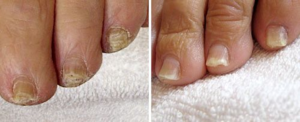Fungal Nail Infection
Abnormal, thickened nails are a frequently encountered problem and can be a source of self-consciousness and embarrassment. They are often caused by fungal infections, although sometimes they are due to a hereditary tendency, inflammatory skin conditions (such as lichen planus and psoriasis) or trauma.
Explore Topics On This Page
- How is the diagnosis made?
- What causes fungal nail infections?
- What treatments are available?
- What about Laser treatment?
- What does laser treatment of fungal nail infection involve?
- What does the nail look like afterwards?
- What special precautions should be taken afterwards?
- How many treatments are needed?
- Results
How is the diagnosis made?
A dermatologist can determine the correct diagnosis by putting the clinical details into context and checking the rest of skin for clues that could indicate that the nail problem is due to inflammatory skin conditions such as psoriasis and lichen planus. Fungal infections can be diagnosed by taking samples for analysis by microscopy and culture in a laboratory.
What causes fungal nail infections?
Fungal nail infection is a frequently seen problem. In some parts of the world the majority of the adult population has fungal nail infection. It usually starts after the nail is damaged and fungal spores enter the keratin/protein of the nail. Fungal spores can be encountered in the environment such as changing rooms and old shoes. Often there can be athletes foot infection between the toe web spaces which is the first site of fungal infection. The fungus grows slowly in the keratin/protein of the nail and causes the nail to become thicker, discoloured and hardened. The nail may so hard that it proves difficult to cut.
What treatments are available?
In the case of inflammatory skin conditions, once the correct diagnosis has been made, then prescription products can be used.
In the case of fungal nail infections topical creams, lacquers or sprays only usually work in the minority of fungal infections which are superficial (usually this type of fungal infection looks like white patches on the surface of the nail). However, the majority of adult nail infections is full thickness and will not respond to creams, lacquers or sprays.
The standard treatment for fungal nail infection is antifungal tablets. The longest established one is griseofulvin, which is not used often as it usually needs to be prescribed for a year in adult nails. The tablet which is used most often is Terbinafine (Lamisil). This is taken once a day until the new nail which is growing out looks clear of fungus. In adults this is usually requires four or five months. However not all adult nail fungal infections are cured by oral tablets. The success rate with oral Terbinafine can be improved with adding a topical lotion/cream but, even then, it is rarely a 100% cure.
The oral tablets have been used for a number of years and many patients have no problems, but some patients do experience side effects. Such side effects include rashes, altered sensation of taste and liver problems. For this reason, liver function blood tests can be done before starting the tablets and every few weeks while taking the tablets to monitor the liver. If there is a pre-existing liver problem, or if certain other medications are being taken, then it may not be safe to prescribe Terbinafine.
What about Laser treatment?
Because of the possible side effects of antifungal tablets there has been increasing interest in using lasers instead. The laser is used to gently heat the affected nail and, in doing so, the hope is that it heats and kills the fungus. The laser which has among the most data for use in the treatment of fungus is the long pulse Nd:YAG. We have several long pulsed NgYag lasers in our clinic, but the one we use for fungal nail infection is by Fotona. However long pulsed NdYag lasers do not usually clear fungus but only stop it growing, so the treatment needs to be repeated every 2-3 months to maintain the appearance of improvement.
Another option is to drill holes into the nail plate using an ablative fractionated laser and then apply an anti-fungal liquid to the nail for several months afterwards until the new nail grows out. As the nail grows out the laser may need to be repeated to create new holes in the new nail as it is growing out.
What does laser treatment of fungal nail infection involve?
The laser treatments work better if the nail is as thin as possible, so it helps beforehand if the nail is filed as thin as possible.
The NdYag laser uses a beam of 8mm diameter which is passed gently over the nail surface to heat it. The laser beam heats up the fungus but leaves the surrounding nail undisturbed and does not damage the background or normal nail.
The fractionated ablative laser option drills small holes through the full thickness of the nail plate. It is usually advised that all the toenails are treated because there may be early fungal infection in the other nails. The patient then applies the antifungal lacquer to the nail twice daily so that it runs into through the holes. These holes grow out as the nail grows and the holes may need to be drilled again in the new nail, as the nail grows.
What does the nail look like afterwards?
If the long pulsed NdYag option is used, the nail looks completely normal afterwards. If the fractionated ablative laser option is used, it creates small holes in the nail plate which grow out as the nail grows out.
What special precautions should be taken afterwards?
It is advised that patients bring a fresh pair of socks/footwear to wear after the procedure. Otherwise no special precautions are needed immediately after the treatment. In order to reduce the chance of re-infection it is important that the nails and surrounding skin are treated with regular applications of antifungal cream and alcohol gel afterwards and that shoes should also be disinfected.
How many treatments are needed?
If the long pulsed NdYag is used it is recommended that the treatment is done monthly for three months and then as a maintenance every three months.
In the case of the fractionated ablative laser the treatment will usually need to be repeated to make fresh holes in the new nail as the nail grows out.



